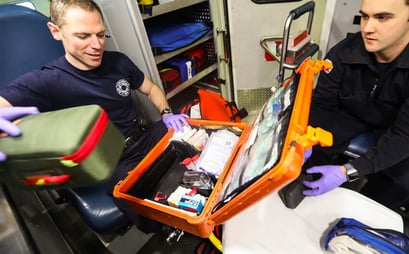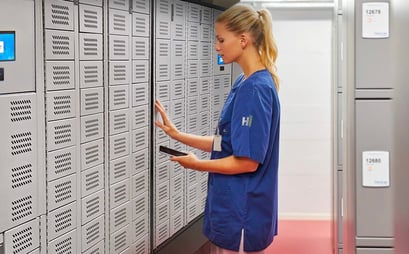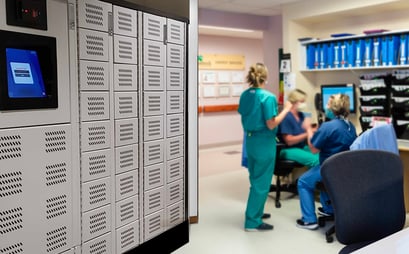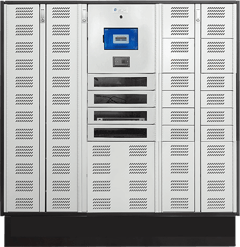By Jay Palter | March 17, 2022
The healthcare system has been under severe strain during the COVID-19 pandemic. Budgets are tight, staff is stretched thin, and there just aren’t enough resources of any kind to go around. As a result, hospitals, EMS agencies, and other healthcare providers are looking for tools that can help relieve the pressure on their overworked personnel.
Looking at the clinic and technical sides of healthcare operations is an obvious place to start. But opportunities for streamlining healthcare administrative and management operations may prove just as fruitful.
Administrative expenses make up a significant portion of healthcare costs, from 15 to 25 percent, by most estimates. That is a large range, accounting for anywhere from $600 billion to $1 trillion. That estimate is broad because many numbers must be estimated. That includes unknowns surrounding equipment management, lost equipment, and stolen equipment.
How much more efficient and affordable could healthcare be if hospital equipment tracking gave us precise figures? Many healthcare centers see success using real-time tracking systems to monitor their equipment, narc kits, and even patient belongings.
This article looks at just some of the uses cases Real Time Networks customers in the healthcare sector have found for smart storage lockers. We also dive into some best practices every healthcare provider will want to follow to improve how they manage equipment and other assets in their facilities.
Smart Lockers Can Improve How You Manage Emergency Medical Services (EMS) Kits
 EMS teams rely on a large amount of equipment, meds, and other items in the field. Many of those items are regulated, most notably their narcotics. Agencies need to ensure they always have an accurate count of those controlled substances and track who used them on a call. Many EMS agencies have turned to using smart lockers to help manage their meds and equipment.
EMS teams rely on a large amount of equipment, meds, and other items in the field. Many of those items are regulated, most notably their narcotics. Agencies need to ensure they always have an accurate count of those controlled substances and track who used them on a call. Many EMS agencies have turned to using smart lockers to help manage their meds and equipment.
A smart locker doesn’t replace a supervising pharmacist or asset manager. It just makes their job easier by automating much of the tedious administrative work involved in tracking assets used by EMTs in the field.
Using an AssetTracer smart locker system, an EMT can be presented with a checklist at kit sign out or return. At sign out, you can prompt them to report any anomalies in medication levels. At return, you can prompt them to record any med use.
Ambulance Companies Benefit from Content Surveillance
 Ambulance companies also need to manage large amounts of critical gear. Before drivers go on calls, everything needs to be prepped and ready. They can't wait for an asset manager to get things organized.
Ambulance companies also need to manage large amounts of critical gear. Before drivers go on calls, everything needs to be prepped and ready. They can't wait for an asset manager to get things organized.
Many ambulance companies use the content surveillance feature in smart lockers to monitor each component in the kits they hand out to EMTs. “Content surveillance” is the name for the automated monitoring smart lockers can perform on items stored in them. Wireless sensors in the lockers read tags attached to kit bags or even individual med vials.
A content surveillance system can instantly verify that every item is returned or taken from a locker. At kit signout, that is an added precaution to ensure no critical component is missed. At kit return, it is an added layer of accountability, helping to ensure no item was misplaced or even to help prevent more serious issues like drug diversion.
Smart Lockers Can Perform Patient Belonging Tracking

Smart lockers aren’t just for hospital and EMS equipment. You can also use them to improve your care of patient belongings and valuables in high-turnover emergency departments or in-patient facilities.
Years ago, a large amount of cash was stolen out of patient belonging bags from one of Real Time Networks’ customer hospitals. They needed a way to store the belongings of high-profile patients securely. They deployed an AssetTracer smart locker system where nurses could deposit patient belongings when they came into the hospital. Each locker could only be unlocked using a unique code assigned to the patient. Once the patient left the hospital, that locker could be reset with a new code for the next patient that came along.
Even if your healthcare center hasn’t struggled with theft in the past, one of these systems can be of great benefit to enforcing your hospital patient valuables policy

See what a smart locker can do for your organization.
Best Practices for Smart Equipment Management in Healthcare
Of course, the equipment and medication tracking needs at every EMS agency and healthcare center are different. Each is dealing with its own unique business and patient demographic challenges. But no matter which specific challenges you’re trying to address, you should follow some universal equipment management best practices. Here are some of the most important ones.
Maintain a Detailed Inventory
Use your smart locker management system to maintain a master inventory of every valuable asset that you need to track within your organization—medical equipment, administrative and IT equipment, medications, everything. Put it all in your hospital asset tracking system. If an item went missing, and it would impact the quality of care you would deliver, it needs to be tracked.
Keep your records detailed. Include relevant information, like serial numbers, warranty information, and the owning department. Collecting this information may feel tedious, but it will pay you back in saved time and management months and years down the road.
Track & Manage Use
Good asset management means doing more than just securing items in lockers. You need to track equipment and medication use over time. That can reveal where your equipment is over- or underutilized. It can also reveal problems in med distribution.
Use the Right Management Tools
Smart locker systems rely on a combination of hardware, software, and sensor systems to provide the security and data collection you need to make valuable business decisions. Look for a locker system that provides the right level of physical security for your facility. And ensure it will give you the insights you need on equipment use.
Optimize Kit and Equipment Distribution
The reporting features of a smart locker system are some of its most valuable tools. As you collect usage data over time, you’ll see trends emerge. In addition, you’ll be able to identify inefficiencies in how equipment is used and optimize how you distribute it.
Automate Consumable Refills and Procurement
This is especially important for healthcare providers using a smart locker system to track narc kits. Use the alert feature in your smart locker’s software to notify you when medications and other consumable items are running low. Users can report low quantities through checklist prompts at the terminal. Content surveillance can also automatically detect when items are out.
Monitor for Problems
Content surveillance and reporting are also invaluable tools for monitoring problems with your equipment. A smart locker system can also automatically relay any concerns to the appropriate personnel.
For example, if an EMT returns a narc kit at the end of a shift and reports that they used their complete supply of naloxone, the smart locker can issue an alert to the supervising pharmacist. They’ll know right away that a critical med needs to be refilled.
Have Quality Controls
You can use sign-in and sign-out checklists to manage workflows beyond equipment tracking. For example, you can prompt returning EMTs to log any issues with their vehicles when returning their medkits. Or you could prompt technicians signing kits out to verify that all of their diagnostic equipment is properly calibrated.
Stick to Maintenance Schedules
You can use a smart locker system to rotate equipment and kit sign-outs to distribute wear and tear across your entire inventory. So you can stop employees from always just picking their favorite kit or the newest piece of equipment.
Get Usage Insights to Inform Future Spending
The usage data you collect will provide valuable insights into how equipment is used across your entire healthcare company. For example, you will be able to see which items are consumed the fastest, which equipment breaks most often, and which ones last the longest.
Invest in Quality Equipment
Smart lockers help healthcare agencies spend smarter. By applying these best practices at your organization, you’ll know what types of medical equipment wear out the fastest, which brands need the least maintenance, and which tools employees want to use the most.
Smart Lockers Deliver Real Value to EMS and Healthcare Providers
Let smart lockers do the heavy lifting of equipment and medication tracking at your healthcare agency. While every healthcare and emergency medical services agency will need to take a different approach to hospital equipment tracking, smart lockers are flexible platforms that can adapt to their unique needs.
Smart lockers can streamline how your agency works. They handle time-consuming tasks so your nurses and technicians can focus on providing better care. Smart lockers can optimize equipment use and improve employee accountability. Healthcare providers of any size and type will quickly see the benefits.
Request a free consultation and see what a smart locker can do for your hospital asset tracking.
Ready to buy an electronic key management system?
Check out our guide:
'Top 10 Purchasing Checklist for Key Management Systems'
Subscribe to our blog

Jay Palter
Vice President of Marketing & Partnerships




